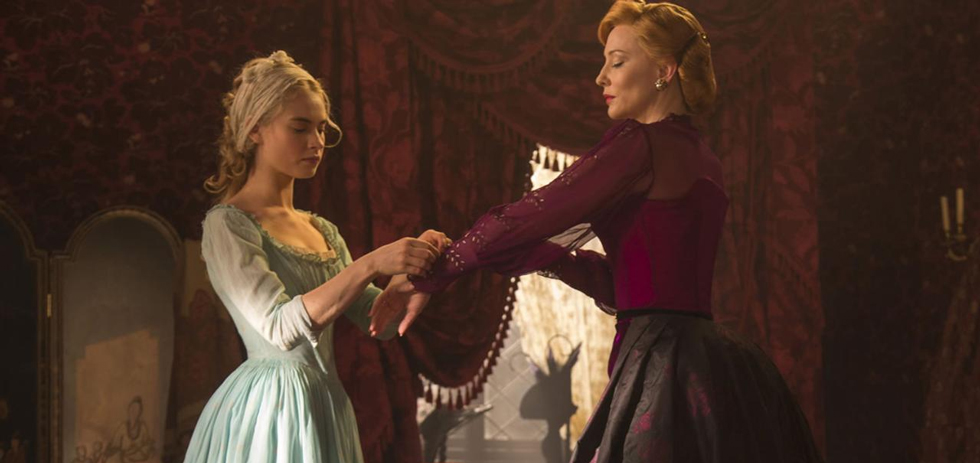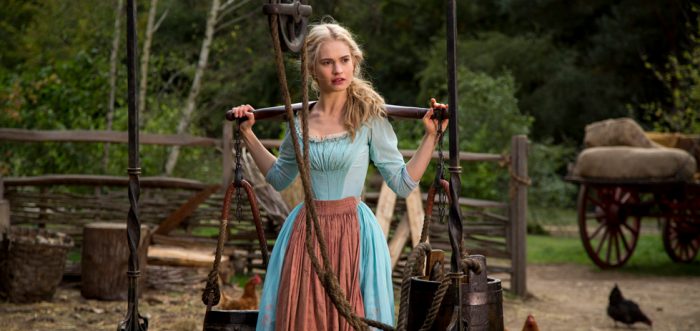
Kenneth Branagh’s Cinderella, or The Perks of Being A Doormat, exists as an ineffective yet strangely backwards exercise in property rebooting. There is no need, surely, to recap the plot – not simply because it is one of the oldest and most familiar fairy tales, but more pertinently because it is rendered here completely loyally, with no additions to the girl-becomes-slave, girl-goes-to-the-ball, girl-meets-prince and girl-is-freed-through-marriage story. The only addition here is to add a thematic interest in kindness and courage – you may have noticed in the trailer that, on her deathbed, Hayley Atwell’s Mother implores a young Cinderella to “have courage and be kind.” Don’t worry if you missed this, however – it will be reiterated in almost every scene of the film.
Other than providing ripe drinking game material, this not-so-sub subtext to the film is rehashed to point of feeling unnatural – this catch phrase soon moves beyond being purely hackneyed writing and on-the-nose moralising, entering a kind of surreal space where it loses any meaning. Much as saying any word enough will make it sound strange and foreign, hearing the characters repeatedly speak of courage and kindness sounds less and less natural each time, completely jolting you out of the scene.
To remake Cinderella in 2015, surely you have to have some unique perspective. The original narrative is hardly a rallying point for empowering female stories – Cinderella is enslaved, and remains so until she’s able to achieve the appearance of the right social class to snag a man. Liberation through marriage doesn’t really fly in a post-feminist world, and the filmmakers attempt to address this by adding the theme of Cinderella’s kindness and courage, perhaps attempting to pander to an idea of “Strong Female Characters”, in and of itself deeply problematic and, if this is the case, completely misused here.
What this serves to do is to reinforce Cinderella’s lack of agency in an entirely unempowering way. Branagh and the film’s writer, Chris Weitz, could perhaps have used the film to critique social conditions that render women impotent in their circumstances, and incapable of liberating themselves. Instead, kindness and courage translates to passivity. The reward for her convincing impression of a doormat is to be rescued by the Prince, and her one moment of backbone, staring down her wicked stepmother, comes only after the Prince has arrived to save her.
Cinderella comes on the heels of Disney’s smash hit Frozen which, for all you might hate the song, carried refreshingly self-reflexive moments in terms of Disney’s fairy tale treatment.1 Just over a year after Elsa told Anna, “You can’t marry a man you just met”, Prince Charming makes a very strong argument for doing just that, as he tries to convince his father he can, indeed, marry that girl he met in the forest that one time.
Perhaps even more disappointing than the film’s treatment of women is its attempts and failures in addressing its treatment of women. Prince Charming’s proclamation that he will marry the mysterious princess with the glass slipper carries the caveat, “if she be willing”. But only minutes later, he is heard to declare, “I don’t care if she doesn’t want to be found, I need to see her”. You know, you almost had it.
The strongest contribution to the film comes easily from Cate Blanchett, who brings an extraordinary depth to a cardboard cut-out villain. Here, too, however, she is undermined by the script. Soon after her introduction as Cinderella’s new stepmother, the camera lingers on Blanchett’s face as she overhears Cinderella’s father talking about his late wife. The loneliness and heartbreak that flitters across Blanchett’s face in this small moment speaks volumes to the character and at a stretch her motivation for her later treatment of Cinderella. Later, however, Blanchett is landed with the most clumsy, moustache-twirling and unclear dialogue as to her reasoning that any work Blanchett has put in is undone. She has some of the best moments and the greatest laughs, but can only hit her stride when not weighed down by the ungainly writing, which seemingly doesn’t quite understand the stepmother as a character, nor what to do with her.
Lily James is perfectly functional, if frustrating, as the eponymous heroine. She suffers far more at the hands of the writer than Blanchett, and is not quite about to save herself in the same way. James is certainly charming and looks the part, but her beatific acceptance of her subjugation is deeply troubling. James is called upon to carry the film but given very little to do beyond smile and wait – it’s little wonder then that Blanchett steals the show.
Richard “King in the North” Madden gives an unnervingly clean shaven performance as Prince Charming, with unsubtly bulging white pants in only the second time he’s played a character who wants to marry someone he only just met in the woods instead of the politically required match. This version has a much happier ending, and surprisingly enough Prince Charming undergoes a satisfying character arc centred around his relationship with his father, a wasted Derek Jacobi. It’s a shame the script doesn’t afford this level of character development to its heroine.

Helena Bonham Carter turns in a good, if small, performance as the Fairy Godmother, giving the character a manic turn that might explain her absence throughout Cinderella’s enslavement up to this point. Rob Brydon appears in an entertaining bit part as the palace portrait painter, and Holliday Grainger and Downton Abbey’s Sophie McShera play enjoyably hateable ugly step sisters. Fellow Game of Thrones alumni Nonso Anozie is solid and likeable as Prince Charming’s offsider, the functionally-named “Captain”. He is one of the few non-white actors given any dialogue of substance, other than Princess Chelina, the arranged marriage Prince Charming is faced with if he doesn’t find Cinderella who squarely, uncomfortably represents the threat of the exotic Other. Outside of this and the household staff, the film is predominantly white washed and despite the humour and nuance he affords his small role, Anozie is nevertheless in a subservient position to Madden’s Prince.
As a director, Branagh seems to be more interested in developing wink-nudge moments than in crafting a cohesive, cinematic whole. The most fun he seems to have with the film is recreating shots from the original cartoon animation, such as Cinderella sobbing inexplicably by the fountain. There are moments of directorial flair – a surprisingly tender close-up of Cinderella’s shoes as she waits by her mother’s deathbed, reinforcing her youth while gently foreshadowing the coming developments. It is telling that these take place outside of the film’s dialogue – perhaps Branagh too is done no favours by Weitz’s script.
Special mention goes to Dante Ferretti’s production design and Sandy Powell’s costumes, which manage to temper the lusciousness of the world or the proclivity of the live-action fairy tale to become simply production design porn, preventing it from becoming over-the-top, overwhelming or boringly one-note.
It is very important to keep in mind that this is very deliberately a G rated film, opening it up to the full range of Disney’s audience. In the current landscape of gritty live action reboots of old studio properties, Cinderella is a rare anomaly, yet it also carries an inherently dark plot, featuring the death of multiple parents and the indentured labour of its protagonist. Caught between these two pulls, it almost gives you pause to wonder why it was made in the first place. But there’s no real question of that. Money. They made it for money.
The rating is important – perhaps we can forgive the film its less than subtle writing, or the more overblown performances. It’s a kid’s film. But we do have to hold it accountable for the gender politics it imparts to its younger viewers which, unfortunately, do not stray far from what the media has been telling young girls for centuries. Buckle in girls, have courage, be kind, the patriarchy will save you, so long as you stay in your place.
